You can transform your space into a sunlit sanctuary by using clever window hacks to maximize daylight. Start by choosing the right windows, like large south-facing options or clerestory windows, which let in ample light. Keep them clean; dirt can block up to 30% of sunlight. Opt for light-filtering treatments like sheer curtains to maintain brightness while preserving privacy. Enhance your decor with reflective surfaces to bounce light deeper into your room. Don't forget to trim any outdoor foliage that may be obstructing your view. There's so much more to explore for creating a luminous atmosphere in your home!
Key Takeaways
- Install south-facing windows to capture maximum sunlight and warmth during the winter months.
- Use sheer curtains or light-filtering shades to maintain brightness while ensuring privacy.
- Regularly clean windows to remove dirt that can obstruct up to 30% of natural light.
- Incorporate mirrors and glossy finishes in your decor to reflect and amplify natural light throughout the space.
- Trim outdoor foliage to allow more sunlight to penetrate into your home and enhance indoor brightness.
Benefits of Natural Light
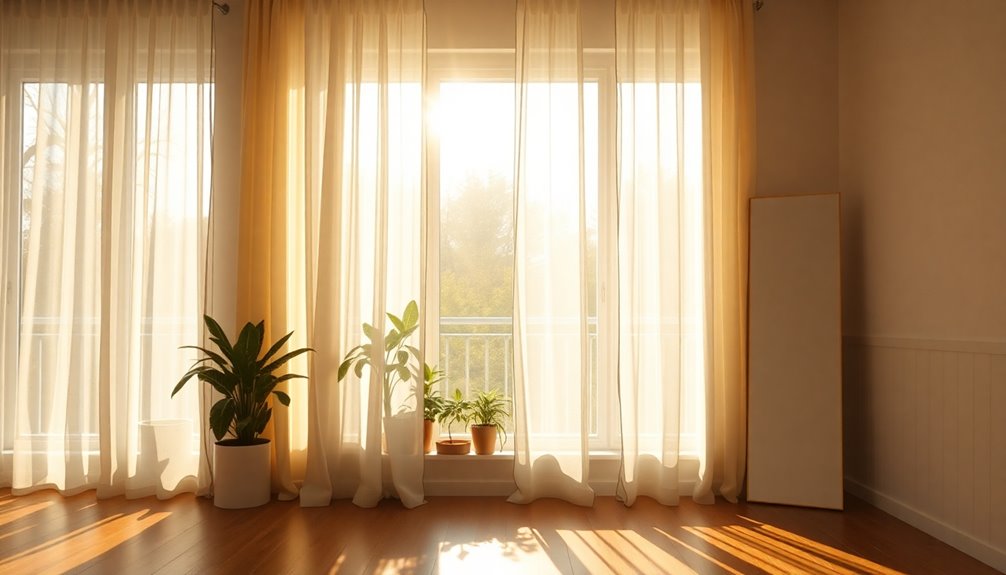
Natural light is a game changer for your home and well-being. By maximizing natural light, you're not just brightening your space, but you're also enhancing your overall quality of life. Exposure to natural light boosts serotonin levels in your brain, which helps improve mood and focus. This effect can be especially beneficial if you're prone to seasonal affective disorder (SAD).
Moreover, homes designed to harness natural lighting can achieve energy savings of up to 25% on heating and cooling costs, making your home more energy-efficient. These savings contribute to a healthier environment and lower utility bills.
Additionally, natural light helps regulate your circadian rhythms, promoting better sleep patterns and increasing vitamin D levels, which are essential for overall health.
Properties that feature ample natural light are often more appealing in the real estate market, enhancing their value. Not only does natural light create a welcoming atmosphere, but it also makes smaller spaces feel larger and more inviting.
Types of Windows to Consider
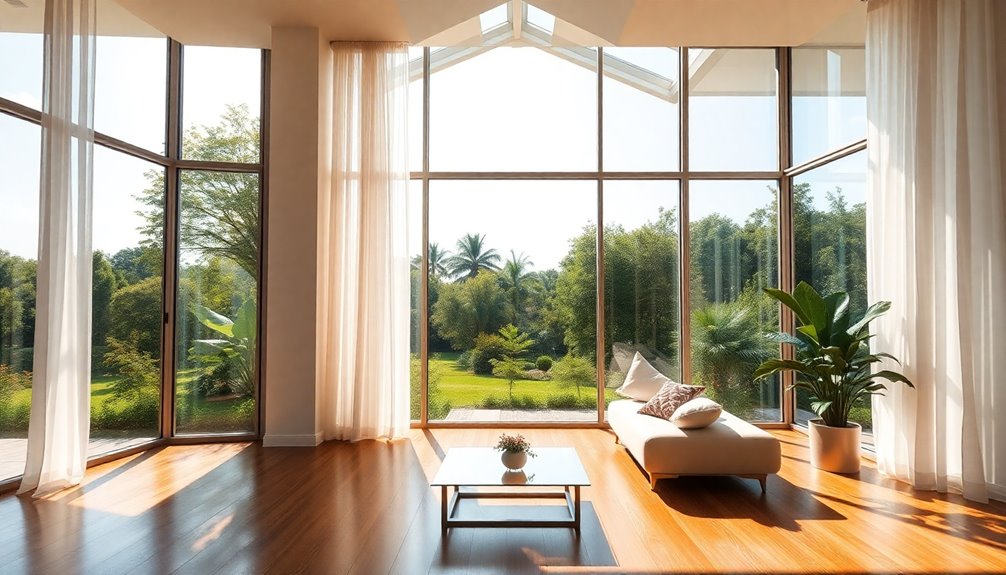
When it comes to maximizing natural light in your home, the type of windows you choose plays an essential role. Fixed windows are a fantastic option if you want to flood your space with sunlight. Since they don't open, they're designed solely to let in light, brightening up any room.
If you need ventilation along with light, consider casement windows. These side-hinged windows open outward, making them perfect for areas that might be hard to reach while still letting in plenty of sunshine.
For a sleek look that offers excellent views, sliding windows are a great choice. Their horizontal sliding mechanism allows for expansive openings, making them ideal for larger spaces.
If you want to enjoy fresh air even in light rain, awning windows are top-hinged and can remain open while still maximizing light entry.
Finally, bay or bow windows can transform your room's feel. These windows extend outward and consist of multiple units, creating a cozy nook while greatly increasing light penetration.
Optimal Window Placement
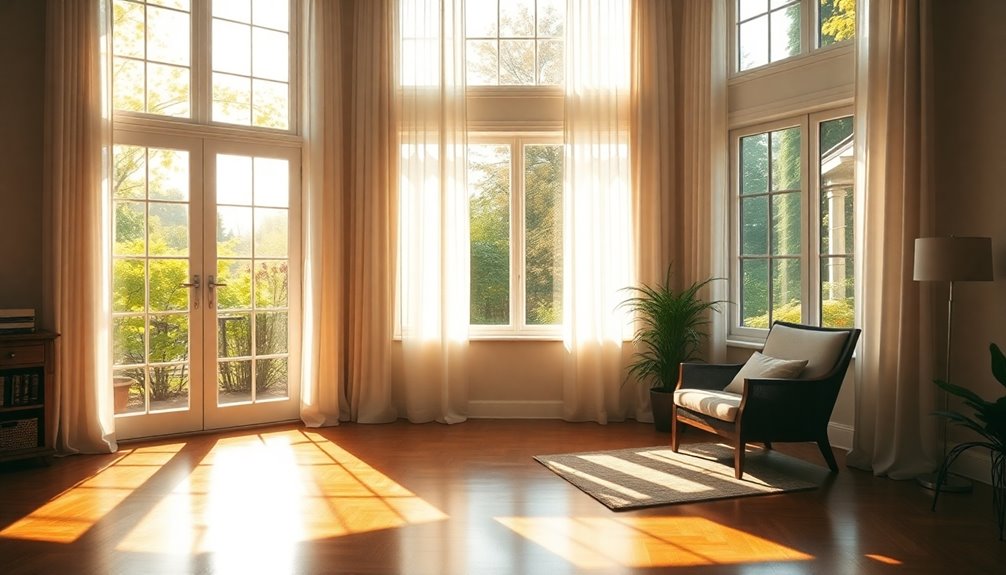
When planning your window placement, consider the benefits of north-facing windows for consistent, glare-free light that's perfect for work areas.
South-facing windows can be a game-changer in colder climates, as they let in direct sunlight to warm your space during winter.
North-Facing Windows Benefits
Although many homeowners mightn't consider window orientation, north-facing windows offer significant advantages that can transform your living space.
These windows provide soft, consistent light throughout the day, allowing you to maximize daylight exposure without the harsh heat typical of south-facing windows. This feature not only enhances energy efficiency but also reduces glare, creating a comfortable indoor environment. Additionally, the use of renewable energy technologies can further complement the benefits of north-facing windows by reducing overall energy consumption. Furthermore, having ample natural light from north-facing windows can help in the growth of large indoor plants, enhancing both aesthetics and air quality within your home. To ensure safety while enjoying the warmth of your space, it's important to maintain proper ventilation standards when using wood stoves for heating.
Particularly beneficial for spaces like art studios or offices, north-facing windows guarantee controlled lighting that's essential for work and creativity. The balanced distribution of light enhances the visual appeal of your rooms while minimizing the need for artificial lighting. This can lead to significant savings on energy bills.
Moreover, homes with ample north-facing windows often experience an improved mood and productivity levels. The steady light promotes a sense of openness and connection to the outdoors, making your living space feel more inviting.
By strategically placing north-facing windows, you can create an atmosphere that encourages creativity and well-being, all while enjoying the practical benefits of energy efficiency and reduced glare. Additionally, incorporating natural materials like wood in your decor can further enhance the warmth and comfort of your space.
Embrace the potential of north-facing windows to elevate your home experience.
South-Facing Sunlight Advantage
Harnessing the power of south-facing sunlight can transform your living space into a vibrant, warm haven. South-facing windows receive the most direct sunlight throughout the day, making them ideal for maximizing natural light and warmth. By strategically placing larger south-facing windows in your living areas, you can enhance interior brightness and create an inviting atmosphere.
In the winter, these windows allow passive solar gain, considerably reducing heating costs by up to 25%. This means lower energy bills while keeping your home cozy.
To combat excessive sunlight in the summer, consider installing overhangs or awnings. They'll help block that harsh glare while still letting in natural light, maintaining comfort levels indoors.
Don't forget about energy-efficient windows, especially those with Low-E glass. They minimize heat loss while optimizing the benefits of your south-facing windows.
Enhancing Light With Design

To enhance light in your space, consider using reflective surfaces like mirrors and glossy finishes, which can dramatically boost brightness. Pair those with light wall colors, such as whites or pastels, to create an inviting atmosphere that feels larger and airier. Incorporating textured fabrics adds warmth and comfort, further enhancing the overall ambiance. Additionally, implementing vertical storage solutions can help maintain an organized environment, allowing natural light to flow freely throughout the space. Together, these design strategies not only amplify natural light but also elevate the overall ambiance of your home. Furthermore, incorporating sustainable materials can contribute to a brighter and more eco-friendly environment. Additionally, incorporating elements inspired by traditional tea ceremony can introduce a serene and mindful atmosphere that complements the brightness of your space.
Reflective Surfaces Strategy
Reflective surfaces can dramatically enhance the natural light in your space, transforming the atmosphere into a brighter, more inviting environment. By incorporating elements like mirrors and glossy finishes, you can maximize daylight and improve light distribution throughout your interiors.
Here's a quick reference table to visualize effective strategies:
| Reflective Surface Type | Benefits |
|---|---|
| Mirrors | Bounce light deeper into rooms |
| Glossy Finishes | Amplify brightness |
| Polished Metals | Add modern aesthetic |
| Glass Tiles | Enhance light flow |
| Light-Colored Decor | Reflect more sunlight |
Strategically placing these reflective surfaces opposite windows directs sunlight deeper into your space, considerably reducing dark areas. Light-colored walls and ceilings reflect about 90% of sunlight, making them ideal for enhancing overall brightness. Additionally, combining reflective surfaces with open layouts can create a sense of spaciousness, making smaller areas feel larger while maximizing daylight entry. By thoughtfully integrating these design elements, you can create an inviting atmosphere filled with natural light.
Light Wall Colors
Light wall colors can transform a room's ambiance, making it feel brighter and more spacious. By choosing shades like whites and pastels, you can enhance the natural light that enters your space, boosting its overall brightness.
Studies show that using light colors can increase the perceived brightness by up to 50%, which means you'll rely less on artificial lighting. This not only creates a brighter space but also helps reduce energy costs.
The reflective properties of light wall colors bounce sunlight around the room, minimizing shadows and fostering a welcoming atmosphere. If you want to maximize this effect, consider high-gloss or satin finishes; they amplify light reflection even more than matte options.
In areas with ample natural light, light wall colors can notably enhance your mood and focus, contributing to improved well-being and productivity.
Effective Window Treatments

Your windows can greatly influence the amount of natural light that fills your space, and choosing the right treatments is key. To maximize light exposure, consider opting for sheer curtains or light-filtering shades. These options allow natural light to stream in while offering you the privacy you need, effectively enhancing daylight without sacrificing comfort.
When you mount curtain rods, place them above the window frame and extend them wider than the window. This simple adjustment invites more light when the curtains are drawn back.
Additionally, reflective window treatments, like metallic blinds or light-colored shades, can bounce sunlight back into the room, amplifying brightness considerably.
Automated shading systems also help optimize natural light throughout the day. They adjust based on sunlight intensity, reducing glare while maintaining a comfortable atmosphere.
Finally, top-down/bottom-up shades offer flexibility in controlling light levels without compromising privacy, making them an excellent choice for maximum daylight utilization.
Importance of Clean Windows

Clean windows are essential for maximizing natural light in your home. Regularly cleaning your windows removes dirt and grime that can obstruct up to 30% of natural light, enhancing overall brightness and visibility. When you use streak-free cleaning methods, like vinegar and water, you guarantee clear views and maximum light penetration, preventing any residue buildup that could block that precious sunlight.
Maintaining clean window frames is just as important as the glass surfaces. Dirt accumulation on frames can cast shadows, diminishing the brightness of your interiors. To keep the natural light flowing, establish a routine cleaning schedule—ideally every few months. This helps prevent the buildup of contaminants that could cause permanent damage or discoloration over time.
Beyond the practical benefits, clean windows also boost the aesthetic appeal of your space. Bright, clear windows create a more inviting atmosphere, positively impacting your mood and well-being.
Strategic Use of Curtain Rods

When decorating a room, strategically placing curtain rods can make a significant difference in how much natural light enters the space. Start by mounting your curtain rods above the window frame. This simple trick extends the visual height of the room, allowing maximum light entry and creating the illusion of larger windows.
Next, consider using wider curtain rods that extend beyond the window edges. This enables you to fully pull your curtains away from the glass, further increasing exposure to daylight hours.
Opt for sheer or lightweight curtain fabrics to soften harsh sunlight while still permitting ample natural light to filter in. Properly placed curtain rods enhance both the aesthetic appeal and functionality of the room, making it feel more open and inviting.
Plus, you can easily install curtain rods yourself, improving light flow and overall ambiance without breaking the bank.
Trimming Outdoor Foliage
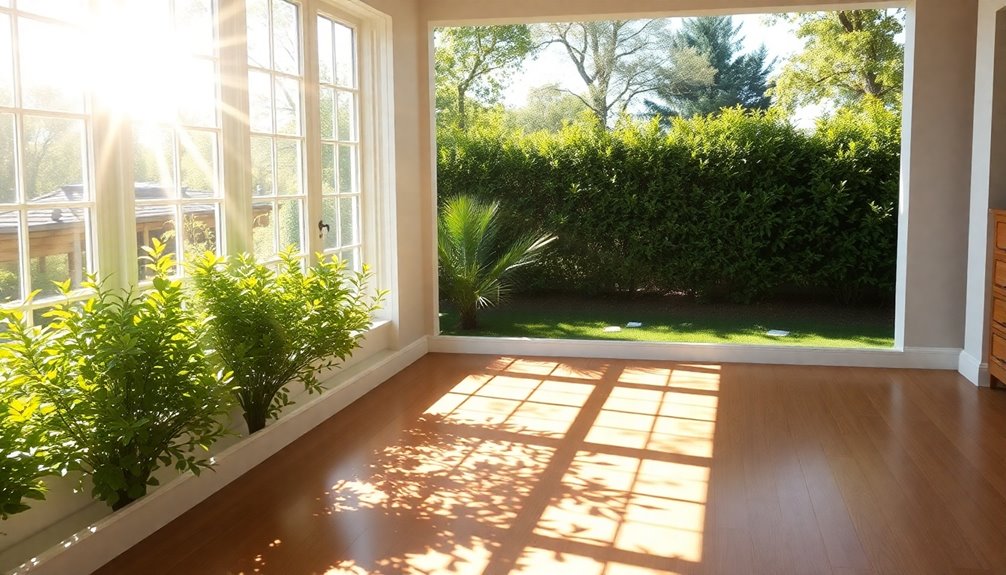
Regularly trimming outdoor foliage can dramatically enhance the amount of natural light that streams into your home. By managing trees and shrubs, you'll allow more sunlight to penetrate, brightening your interior spaces. Following the one-third pruning rule helps maintain healthy plant structure, ensuring that greenery doesn't overshadow your windows, which is essential for ideal light access.
Here's a quick guide to effective trimming:
| Foliage Type | Trimming Frequency | Benefits |
|---|---|---|
| Small Shrubs | 1-2 times/year | Increases light and air circulation |
| Medium Trees | Annually | Reduces heat, enhances sunlight |
| Large Trees | Every 2-3 years | Opens space without blocking views |
| Vines | Seasonal | Controls growth and light access |
| Hedges | 2-3 times/year | Maintains shape and light entry |
Strategically managing your outdoor greenery not only boosts natural light but also creates a more inviting atmosphere. Seasonal trimming helps adapt to changing sunlight patterns, ensuring consistent light levels in your home while improving comfort and reducing heat.
Innovative Light-Boosting Solutions
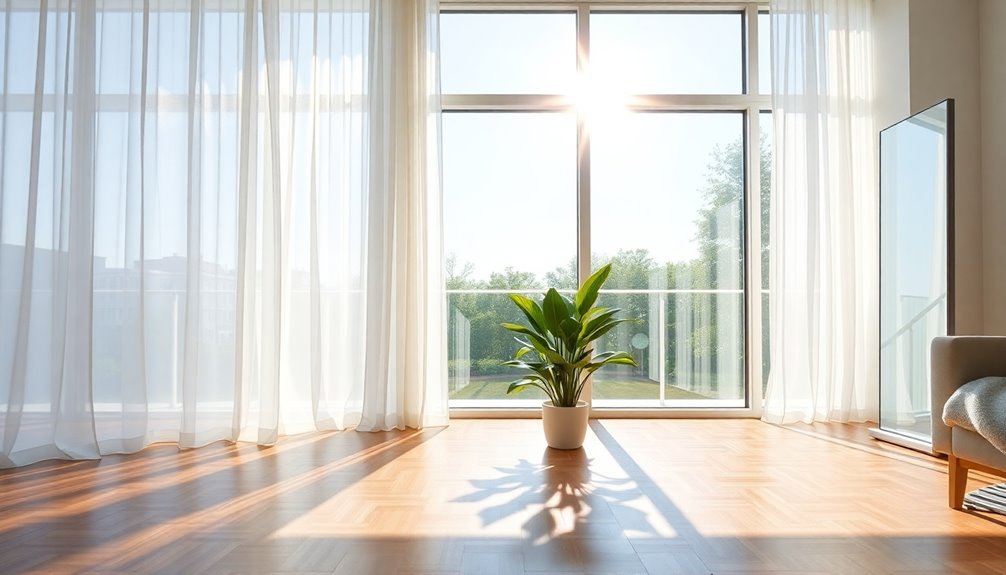
Transforming your home into a bright, inviting space can be achieved through innovative light-boosting solutions. Start by installing light tunnels, which effectively channel natural light from your roof into darker areas of your home, enhancing brightness without traditional windows.
Reflective surfaces, like mirrors or glossy finishes, can also amplify the amount of light into a space, redirecting it throughout the room and creating a brighter atmosphere.
Consider the strategic placement of oversized windows, particularly south-facing ones, to maximize light entry and warmth, reducing your reliance on artificial lighting during the day.
Additionally, incorporating clerestory windows helps increase natural light while maintaining privacy, allowing you to illuminate your home without sacrificing wall space.
Finally, choose light-filtering window treatments, such as sheer curtains. These options soften harsh sunlight while still allowing ample natural light to penetrate your rooms.
Frequently Asked Questions
How to Maximize Light From a Window?
To maximize light from a window, start by positioning mirrors across from the window to reflect sunlight throughout the room.
Use sheer curtains instead of heavy drapes, allowing more natural light to filter in while still providing some privacy.
Regularly clean your windows to remove dirt and grime, ensuring they're as clear as possible.
You might also consider painting the walls in light colors to enhance brightness and create a more inviting atmosphere.
How to Get More Light in Window Well?
Think of your window well as a treasure chest waiting to be filled with light.
To optimize it, start by clearing out debris that blocks sunlight. Next, install reflective surfaces, like mirrors, to bounce light deeper into the space.
Paint the interior walls in light colors for added brightness. Consider adding a clear grate for protection while allowing more light in. These simple tips for home decor can make a big difference in the overall feel of your home. Additionally, using light colors on the walls can create the illusion of a larger space, making the interior feel more open and airy. Adding a clear grate not only protects the walls from damage but also allows natural light to filter through, brightening up the room even more.
Finally, choose low-growing plants around the well to prevent shadows from creeping in.
How to Mimic Daylight in a Windowless Room?
To mimic daylight in a windowless room, you can start by using bright, reflective surfaces like mirrors and glossy finishes.
Incorporate full-spectrum LED bulbs that simulate natural light, and paint your walls in light colors to enhance brightness.
If possible, install skylights or light tubes for direct light.
Adding plants with grow lights not only livens up the space but also helps create a more natural atmosphere.
These steps will transform your room effectively.
What Are the Suggestions for Improving Daylight Illumination?
To improve daylight illumination in your space, start by installing larger windows or opting for floor-to-ceiling designs.
You can enhance brightness by using light-reflective surfaces, like mirrors.
Pay attention to your window orientation; south-facing windows bring in the most sunlight.
Consider adding skylights or light tunnels for areas without direct light.
Finally, choose sheer or light-colored window treatments to maximize natural light while maintaining privacy, creating an inviting atmosphere.









